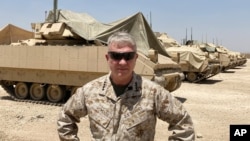ສະຫະລັດບໍ່ມີແຜນທີ່ຈະໃຫ້ການສະໜັບສະໜຸນ ແກ່ກຳລັງອັຟການິສຖານດ້ວຍການໂຈມຕີທາງອາກາດ ຫຼັງຈາກການຖອນທະຫານຂອງສະຫະລັດເສັດສິ້ນລົງແລ້ວ ແລະການໂຈມຕີຕໍ່ຕ້ານພວກກໍ່ການຮ້າຍໃນອັຟການິສຖານ ຈະມີການຈຳກັດຢູ່ແຕ່ເວລາໃດມີການຄົ້ນພົບແຜນການໂຈມຕີຕໍ່ສະຫະລັດ ຫຼືປະເທດພັນທະມິດຂອງພວກເຮົາເທົ່ານັ້ນ ອີງຕາມຄຳເວົ້າຜູ້ ບັນຊາການກຳລັງຂອງສະຫະລັດໃນພາກຕາເວັນອອກກາງ.
ນາຍພົນແຟຣັງ ແມັກເຄັນຊີ (Frank McKenzie) ຜູ້ບັນຊາການກຳລັງສະຫະລັດ ໃນພາກຕາເວັນອອກກາງ ຫຼື CENTCOM ກ່າວຕໍ່ວີໂອເອ ໃນການໃຫ້ສຳ ພາດພິເສດ ລະຫວ່າງທີ່ເດີນທາງໄປຍັງຂົງເຂດດັ່ງກ່າວ ຢູ່ເທິງເຮືອບິນທະຫານຂອງສະຫະລັດໂດຍເວົ້າວ່າ “ນັ້ນແມ່ນເຫດຜົນສຳລັບການໂຈມຕີໃດໆກໍຕາມ ທີ່ທີ່ພວກເຮົາຈະເຮັດຢູ່ໃນອັຟການິສຖານ ຫຼັງຈາກພວກເຮົາໄດ້ຖອນອອກໄປແລ້ວ ມັນອາດຈະເປັນພວກເຮົາຄົ້ນພົບບຸກຄົນໃດບຸກຄົນນຶ່ງທີ່ຕ້ອງການຢາກຈະໂຈມຕີປະເທດສະຫະລັດ ນຶ່ງໃນພັນທະມິດແລະພາຄີຂອງພວກເຮົາ.”
ການໃຫ້ຄວາມເຫັນດັ່ງກ່າວ ຂອງນາຍພົນແມັກເຄັນຊີ ປາກົດວ່າເປັນການປະຕິເສດຕໍ່ລາຍງານຂ່າວຂອງໜັງສືພິມນິວຢອກໄທມ໌ ທີ່ກ່າວວ່າ ທຳນຽບຫ້າແຈກຳລັງພິຈາລະຈາເພື່ອໃຫ້ການອະນຸມັດຕໍ່ການໂຈມຕີທາງອາກາດສຳລັບໃຫ້ການສະໜັບສະໜຸນຕໍ່ກຳລັງຮັກສາຄວາມສະຫງົບຂອງອັຟການິສຖານຖ້ານະຄອນຫຼວງກາບູລຫຼືຫົວເມືອງທີ່ສຳຄັນອື່ນໆຕົກຢູ່ໃນອັນຕະລາຍ ໂດຍພວກຕາລີບານຈະເຂົ້າຄວບຄຸມ.
ການເວົ້າຢ່າງເປີດເຜີຍກົງໄປກົງມາຂອງນາຍພົນແມັກເຄັນຊີ ກ່ຽວກັບການພົວພັນຂອງສະຫະລັດໃນອັຟການິສຖານ ຫຼັງຈາກການຖອນທະຫານຂອງຕົນ ບັງເອີນມີຂຶ້ນໃນຂະນະທີ່ການປະຕິບັດງານບຸກໂຈມຕີກຸ່ມລັດອິສລາມ ແລະກຸ່ມອາລກາອີດາຫຼຸດນ້ອຍລົງ ໃນຂະນະທີ່ທຳນຽບຫ້າແຈຈະໃຫ້ບູລິມະສິດຫຼາຍຂຶ້ນສຳລັບການແຂ່ງຂັນກັບຈີນແລະຮັດເຊຍ. ນາຍພົນແມັກເຄັນຊີເວົ້າວ່າກຳລັງຂອງທ່ານ ໃນພາກຕາເວັນອອກກາງ ເວລານີ້ມີຢູ່ “ເກືອບ 40,000 ຄົນ” ຊຶ່ງເປັນການຫຼຸດລົງທີ່ສຳຄັນຈາກ 18 ເດືອນກ່ອນ ຊຶ່ງໃນເວລານັ້ນ ທ່ານມີກຳລັງລະຫວ່າງ 60,000 ຄົນ
ຫາ 80,000 ຄົນ.
ນັບແຕ່ປະທານາທິບໍດີໂຈ ໄບເດັນ ໄດ້ເຂົ້າຮັບຕຳແໜ່ງ ທ່ານໄດ້ສັ່ງໃຫ້ຖອນທະຫານອາເມຣິກັນທັງໝົດອອກຈາກອັຟການິສຖານແລະຫຼຸດກຳລັງທະຫານສະຫະ ທີ່ໃຫ້ການສະໜັບສະໜຸນ ຕໍ່ການບຸກໂຈມຕີ ທີ່ນຳພາໂດຍຊາອຸດີ ອາຣາເບຍ ຕໍ່ພວກກະບົດຮູຕີ ທີ່ໄດ້ຮັບການໜຸນຫຼັງຈາກອີຣ່ານໃນເຢເມນ ຊຶ່ງທັງໝົດນີ້ມີຂຶ້ນໃນຂະນະທີ່ທຳນຽບຫ້າແຈຍ້າຍກຳປັ່ນລົບ ລະບົບອາວຸດແລະທະຫານອອກຈາກປະເທດຕ່າງໆໃນພາກຕາເວັນອອກກາງ.
ນາຍພົນແມັກເຄັນຊີກ່າວວ່າ ການຖອນກຳລັງທະຫານອອກຈາກອັຟການິສຖານແມ່ນເປັນເຫດ ການສຳຄັນ ທີ່ໄດ້ເຮັດໃຫ້ເກີດຄວາມເຄັ່ງຕຶງທາງດ້ານຊັບຍາກອນບໍ່ພຽງແຕ່ພາຍໃຕ້ການບັງຄັບບັນຊາຂອງທ່ານ ແຕ່ມີຂຶ້ນໃນທົ່ວກອງບັນຊາການດ້ານຂົນສົ່ງຂອງສະຫະລັດ ທີ່ໄດ້ຊ່ວຍຂົນເອົາທະຫານ ແລະອຸບປະກອນໄປຍັງສະຖານທີ່ໃນແຫ່ງຕ່າງໆຢູ່ໃນທົ່ວໂລກ.
The United States is not planning to support Afghan forces with air strikes after the U.S. troops withdrawal is complete, and counterterrorism strikes in Afghanistan will be limited to instances when attack plans have been discovered to strike the U.S. homeland or the homelands of our allies, according to the top U.S. commander in the Middle East.
“That would be the reason for any strikes that we do in Afghanistan after we leave, (it) would have to be that we’ve uncovered someone who wants to attack the homeland of the United States, one of our allies and partners,” Gen. Frank McKenzie, the commander of U.S. Central Command, told VOA in an exclusive interview as he traveled toward the region aboard a U.S. military plane.
The general’s comments appear to refute a report by the New York Times that said the Pentagon is considering seeking authorization to carry out airstrikes to support Afghan security forces if Kabul or another major city is in danger of falling to the Taliban.
McKenzie’s candid description of U.S. involvement in Afghanistan after its withdrawal coincides with a narrowing counter-terror offensive against Islamic State and al-Qaida as the Pentagon prioritizes competition with China and Russia. The general said his force size in the Middle East was now “closer to 40,000,” a significant reduction from 18 months ago, when that number was between 60,000-80,000 troops.
Since President Joe Biden took office, he has ordered the full withdrawal of U.S. troops from Afghanistan and cut U.S. military support for the Saudi-led offensive against Iranian-back Houthi rebels in Yemen, all while the Pentagon has moved ships, weapons systems and troops out of other Middle East nations.
McKenzie says the withdrawal from Afghanistan is a major event that has strained resources, not only across his command, but also across the U.S. Transportation Command, which helps shuttle U.S. military people and equipment to various locations across the globe.
Those resources will continue to be strained, he tells VOA, as U.S. aircraft will fly from bases thousands of kilometers away in order to gather intelligence and surveillance and “keep the pressure up” on terrorists in Afghanistan.
“It’s a long haul to get forces, aircraft into Afghanistan from over the horizon. We’ve said all along this is a very difficult thing to do. It’s not an impossible thing to do, and we’re working that right now,” McKenzie said.
Experts and former commanders have raised concerns about the lack of details that have been associated with securing Afghanistan after the withdrawal.
“The plans are very well advanced,” McKenzie said, deferring to the Defense Department to release further information.
Ret. Gen Joseph Votel, the former commander of CENTCOM, told VOA he has hoped to see a “more comprehensive plan for what this withdrawal would look like” in order to leave the government of Afghanistan and the Afghan forces “on the very best footing that we could.”
He pointed to the 2011 withdrawal of U.S. forces from Iraq as a “much more deliberate approach” that left behind a large embassy and left a security cooperation element of special forces on the ground.
“Those are the kinds of things that that I would be expecting to see. I think the challenge with this right now is we’re just not seeing a lot of details,” Votel added.
According to McKenzie, the U.S. will help the Afghan air force, one of the country’s biggest advantages against the Taliban, maintain its aircraft through a combination of virtual advising from afar and flying parts in and out of the country. The method will undoubtedly slow the maintenance process, which could leave Afghan forces with limited air support.
“Risk will be greater, significantly greater,” McKenzie acknowledged.
There is also a complete plan to evacuate Afghans who helped the United States, should the need arise, although the size, scope and timing of the operation would come from the Department of State, he said.





